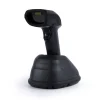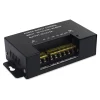According to a 2020 report, companies that implemented a barcode generation system recorded an average productivity increase of 8.2%. This demonstrates the importance of implementing such a solution to streamline the warehouse management process.
Barcodes are one of the most popular and widespread methods of product identification. They were introduced in the 1960s and since then have become an integral part of many business processes, both in stores and warehouses. The primary goal of barcodes is to enable quick, easy, and convenient transactions and product tracking. Properly generated barcodes allow companies to track their products and improve collaboration with customers.
Barcode generation is a process where data is transformed into a code that can be scanned to access information. The use of this technology is widespread, which leads many companies to ask: how to generate barcodes?
In this article, we will discuss:
What is a barcode and what are its types?
There are many different types of barcodes used in various situations. In this section, we will take a closer look at what barcodes are and the types of barcodes available.

What is a Barcode?
A barcode is a symbol that we encounter at every turn. Over the past several decades, it has developed so much that today we can’t imagine functioning without it in the economy. However, not everyone knows that a barcode is not just a mark assigned arbitrarily to a product. It is the most commonly used product coding system, enabling quick reading and memorization of product information.
A barcode contains information such as the product number, price, or other significant details. Barcodes are used in various places, including warehouses, wholesale outlets, stores, and supermarkets. They facilitate the work of cashiers and make product scanning faster and simpler. Additionally, their marking varies depending on the country of origin. More on this in the article: Barcode and Country of Origin.
Did you know...
- The barcode was invented in 1974 by Norman Joseph Woodland and Bernard Silver.
- The first barcode consisted of a single rectangle, three horizontal, and three vertical lines.
- It was first used in a store in 1974.
- In 1977, IBM introduced the first barcode scanner for commercial use.
- The barcode became so popular that by 1988, it was implemented in airplane flight systems.
- Today, barcodes are used in over 200 countries around the world.
Most Popular Types of Barcodes
We most commonly encounter barcodes during the routine activity of shopping. Every product we wish to purchase has a barcode, most often it is the EAN-13 code. This is the most popular type of code used for product labeling in Poland. It consists of a fixed number of 13 characters and is always numeric. In addition to this type of code, the following types are also used:
- Code 39 – This is a three-digit barcode used to label products that are to be shipped to other countries.
- Code 128 – This is a seven-digit barcode used for labeling products manufactured by a company.
- EAN-8 – This is an eight-digit barcode used for product identification worldwide.
- UPC-A – Consists of 12 digits, the first 6 of which indicate the manufacturer’s identifier, and the remaining 6 – the identifier of a specific product.
- UPC-E – This is a condensed barcode used in the United States for product identification. It is 8 characters long and is primarily used to identify low-value products.

If you want to learn more about barcode types and types of barcodes, go to the article on barcode types.
How and Where to Generate Barcodes?
In this section, we’ll discuss how and where to generate barcodes for maximum efficiency.
Commercial Use Barcodes
Types of codes used commercially in sales are assigned to products by the international organization GS1. The aim of the organization is to streamline operations in broadly defined logistics. Its main headquarters is located in Brussels. Applications are submitted here, and within a few days, you will receive a batch of codes for your products. A detailed price list for the service is available on the GS1 Poland website.
Barcodes for Personal Use
However, not all codes need to be assigned by the GS1 organization. Thanks to barcode generators, anyone can assign their own codes and use them for internal purposes. Apart from numeric codes, you can generate alphanumeric codes, for example, using the Code 128 symbology. This type of code allows encoding both digits, letters, and special characters in a single code. There’s also the option to generate 2D codes, which are increasingly common in everyday use, such as QR codes. You can find a free barcode generator here.
Personal barcodes can be used in many cases:
- Own labeling of selected products,
- Marking locations or sectors in a warehouse,
- Marking warehouse or sales documents,
- A single collective code for several packages of the same product,
- Saving information about your company in a QR code,
- Saving the website address of the company in a QR code,
- And many other situations not listed here.

Is It Worth Implementing a Barcode System?
In today’s world, technology has become an integral part of all fields. In warehouses, technology is also used to facilitate resource management and optimize process efficiency. Barcode systems are one of the most popular solutions used in warehouses. Implementing a barcode system in a warehouse shows many benefits, including increased efficiency.
What Are Barcode Systems?
Barcode systems are interactive information systems that enable tracking and identification of products. These systems consist of barcodes that are placed on products. Each product has a unique code, which is used for identification, tracking, and product management. Barcode systems are often used in warehouses to simplify resource management and increase efficiency.
Benefits of Implementing a Barcode System in a Warehouse
Implementing a barcode system in a warehouse brings many benefits, including increased efficiency. Here are some key benefits of using barcode systems in a warehouse:
- Improved Work Efficiency: Barcode systems allow warehouse teams to scan products faster, significantly increasing work efficiency. Scanning barcodes is faster and more accurate than traditional methods, such as manual data entry.
- Reduced Errors: Barcode systems enable warehouse teams to make significantly fewer errors. A barcode automatically verifies data, significantly reducing the risk of mistakes.
- Easier Access to Data: These systems allow for easier access to data through barcode scanning. Data is displayed in real-time, allowing warehouse teams to respond more quickly to changing conditions.
- Time and Money Savings: Implementing a barcode system in a warehouse helps the company save time and money by significantly reducing the number of work hours needed to perform specific tasks.
Implementing such a system also shows clear positive increases in company statistics compared to entities that have not introduced such a system. Here are some of them:
- About a 30% reduction in product turnaround time
- About an 80% reduction in data entry errors
Summary
In this article, we learned about the impact of barcodes on resource management. Various technologies and systems that allow generating barcodes were presented. It was explained how barcodes could affect the efficiency and productivity of a company.
![High-level security and control – Access Control Systems [2024]](https://hdwrglobal.b-cdn.net/wp-content/uploads/2024/04/transparent-thegem-product-justified-landscape-s.png)













